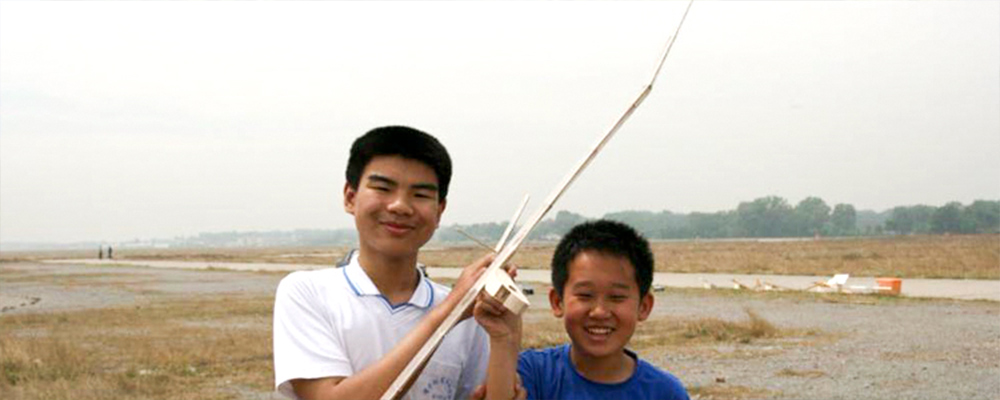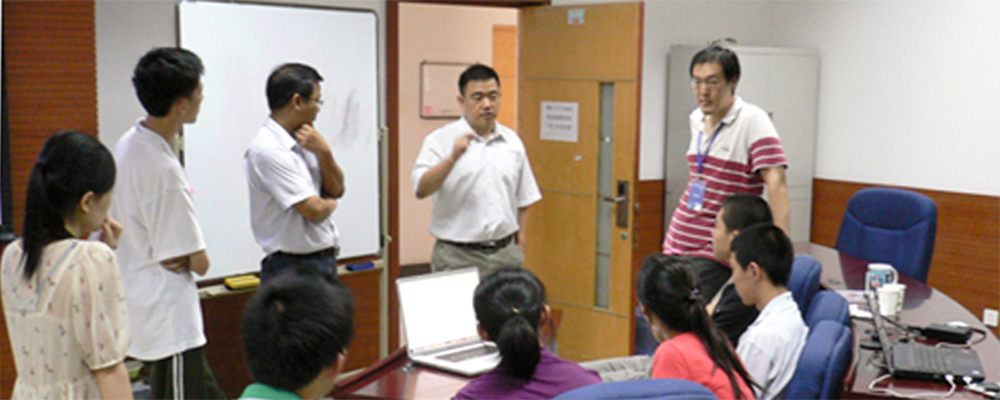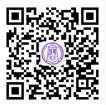Office of Science & Technology
Office of Science & Technology
In order to provide a better science research platform for extra-talented students in TUHS, TUHS cooperated with Thomas Jefferson High School for Science and Technology, which is the best of its kind in the United States, whose high-end laboratory systems were introduced to TUHS. In Feb, 2015, TUHS sent five teachers with Prof. Gu of Tsinghua University to the U.S. to learn laboratorial construction of software and hardware and made a more detailed plan when Thomas Jefferson High School teachers visited TUHS in July, 2015. The first four laboratories successfully constructed are Robot and Automation Laboratory, Energy System Laboratory, Resource Environment and Geographical Information Laboratory, and Computer Science Laboratory. Later in 2016, constructions of Chemistry Laboratory and Biological Science Laboratory were also completed, forming a comprehensive system for TUHS students' science projects. The establishment of these high-end research laboratories provides an internationally compatible open source platform for students' development, opening a new chapter in TUHS science education.
Computer Science Laboratory
TUHS Computer Science Laboratory is a comprehensive laboratory featuring the integration of theoretical and practical innovations. Students from the Innovative Class with basic programming and coding knowledge and good logical thinking abilities are selected to join this laboratory. Currently, there are altogether 10 students and two coaching teachers in this laboratory. Having learned C, Java, iOS coding languages, students are able to accumulate programing experience, practice innovative thinking, design software, mobile phone applications and user interfaces that interest them and apply what they have designed to daily life. Based on the knowledge and skills they acquired, students can further enhance their logical and innovative thinking abilities and practice their team working and time management abilities.
Project Introduction
Reproducing The Belt and Road using Unreal Engine 4 and VR technologies
To vividly recreate The Silk Road, the way of combing story game and VR technologies is proposed. It is decided that the game shall center on interactive ancient trade experience. Based on that, Unreal Engine 4 with its physics engine, rendering engine, blueprint tool, editor and motion system is chosen as the tool to create the game. Meanwhile, the effect of the game is further magnified with the excellent GPS function of HTC vive VR glasses and the immersive experience that come along with it. With these, users are able to have a vivid on-the-spot "silk road" experience.
Creating 3D Concert Scene using HoloLens
Learning a musical instrument has always been the best choice for people to enjoy life and appreciate music. If people are not very sure of their real interest, they might give up halfway so that many of them cannot easily decide on the purchases of big musical instruments such as piano. For more people to have the opportunity to learn and enjoy piano, the Lab proposes a project to develop virtual pianos using HoloLens, a kind of VR glasses made by Microsoft and researches into AR techniques using Windows 10 holographic development platform Unity 3D. HoloLens can rapidly scan and analyze surrounding environment, accurately place or present hologram in real world, and thus virtually create a piano and provide VR experience. Through image recognition and gestures, users can learn to play piano and other musical instruments and create concert scenes.
Robot and Automation Laboratory
The major areas of Robot and Automation Laboratory are robotics, robot technologies, intelligent control theories and technologies and automation applications. The Lab has made some progress in intelligent technologies and information processing and control. In the following laboratorial constructions and operations, emphasis will be made on intelligent healthcare, gesture control, environmental protection and unmanned aerial vehicle researches. Students of the Lab can be a programmer, a hardware engineer, a mechanical or a designer. A boundless stage and cutting edge projects are what the Lab can offer.
Project Introduction
Self-stable Remote Control Aerial Photography Airship
It is a kind of aerial photography devise that is different from existing unmanned aerial vehicles (UMVs). The camera is carried by an airship. A remote control aerial photography airship consists of major airbag (minor airbag), sternpost rudder, engine, flight control and camera. It is more stable than UMVs and has a longer battery life, which makes it particularly suitable forlong time shooting and monitoring.
Gesture Control System
The goal is to develop a gesture control system and make it an open-source so that it can control various kinds of executive systems, such as home applications, danger-proof mooring UMVs, disaster rescue vehicles etc. The core is gesture control, different from remote control box or mobile phone. Currently, the most practical way of gesture control is data glove, which has been proved to be feasible in aforementioned areas. It can greatly enhance the portability of the devise and thus is more convenient to use. The project has a modular design and can be matched against other devises.
Semi-automatic Desert Tree Planting Machine
In China, desertification is a very serious problem and in Northwestern China, a large area of fertile farmland has become desert due to human and climate reasons. Based on these problems and current situations, the Lab designs a desert tree planting machine that can greatly reduce the time used for planting. With this machine, a large number of trees can be planted in a short period of time, which can improve the average survival rate of each tree because of its quantity advantage. Besides, the machine can bury tree roots deeply in the ground so that they can better absorb underground water. According to the design, the machine has three parts: a removable rectangular pyramid made of acrylic, four motors that control the opening of the rectangular pyramid and an energy-supply devise. All the three parts are made in one backpack, making it a semi-automatic tree planting machine that only needs two people and requires no extra energy support.
Multi-parameter Fusion Based Senior Citizen Fall Detection System
Senior citizens are more likely to fall, which can lead to serious consequences. As a matter of fact, falling has become the No.1 cause of death and casualty for senior citizens. However, with the instant fall detection system, the harm caused by falling can be largely reduced. Currently, there are three kinds of fall detection technology: video image based, acoustic signal based and wearable technique based. Concerning privacy and convenience, most people find wearable technique based fall detection more acceptable. However, since wearable technique based fall detection mainly relies on inertial sensor, it does not give very satisfactory analysis if the person falls sideward or does not end up lying flat on the ground. Thus, the project proposes a multi-parameter fusion based fall detection system that can realize high precision intelligent fall detection using information from the distributed pressure sensor on the shoe pad, inertial sensor and height sensor.
Energy System Laboratory
Energy System Laboratory is one of the earliest laboratories built in TUHS and its major research areas are energy saving and environmental protection, energy efficiency and control system as well as new technologies such as electroencephalogram and motion control. The Lab has developed an integrated high school science project education system that involves course learning, project training, project developing proposal, resource matching and project closing oral defense. Currently, the ongoing projects of the Lab have obtained support from various departments and schools of Tsinghua University and Microsoft Company, who promise to provide all-round assistance to students' project developing and research.
Project Introduction
Wearable and Removable Vertical Axis Spiral Wind Turbine
Human beings have been using wind power for thousands of years. Construction of wind power plants started in Denmark in the 19th century. The earliest way to exploit wind power was through vertical axis windmill. But it wasn't until 1920s that vertical axis wind turbine started to appear. In the 1920s and 1930s, energy tension caused by global economic crisis led to the idea of using wind power as energy supplement. With the development of lift-type wind rotor, vertical axis wind turbine is no longer lower than horizontal axis wind turbine in wind power utilization and is even easier in maintenance, simpler in blade design and manufacturing, lower in price and does not require a yaw device.
Since the gear case of the generator of vertical axis wind turbine is at the bottom, the turbine has a lower gravity center and thus is more stable and easier to maintain, which reduces the cost. Moreover, vertical axis wind turbine does not require a wind facing adjustment system and can accept wind from all directions. The main axis always moves towards the designed direction. In addition, the tip speed of the blades of vertical axis wind turbine is lower than those of horizontal axis wind turbine, resulting in fewer noises. Thus it can be installed in public facilities, street lamps and residential buildings where noise level should be kept low. To sum up, vertical axis wind turbine can be widely applied and has a very promising future.
Piezoelectric Effect Based Spiral Breeze Power Generator
With the development of economy and increase of population, energy consumption is soaring. Development and exploitation of energy resources has become the center of public attention. As for China, since mass employment of fossil fuels has led to serious pollution, new and clean energy are badly needed. Traditional wind power generator is low in efficiency and high in cost. With several years of research and development, piezoelectric power generation has become second to thermal power generation with its low cost and non-electromagnetic interference. It is plausible to use wind pressure to produce deform in piezoelectric elements and thus generate electricity, which in the meantime is likely to improve generating efficiency and lower equipment cost. To reduce start up wind speed, S-shape blades and piezoelectric cantilever beams are used.
Motor Imagery Based Brain Trace Password
Lack of security is a common problem for most electronic locks now available on market. The project aims to create a brain-control electronic lock to significantly improve the security level of locks. With a sensor, this electronic lock can identify the changes in brainwave during brain activities to program passwords and complete the unlocking procedure. The whole process relies on Bluetooth connections for information transmission. Compared with other bioinformatics electronic locks, it is more secure since the passwords cannot be let out, duplicated nor cracked.
Kinect Based Motion Control New Smart Home
Smart home is a hot spot that realizes the Internet + Concept Application and is an area of science and technology that closely relates to people's daily life. Since most smart home products do not have a very good user experience, the project aims to integrate 3D data and motor control with smart home system so that users can have more natural interactive experiences. Meanwhile, the project also plans to apply intelligent recognition technologies so that every family member can enjoy a more customized way of interaction. The major hardware used in this project is Kinect (v2.0) developed by Microsoft. It is used to identify human body data to realize motion control. The project develops its own software based on Kinect including gesture recognition, face recognition to achieve expected goals.
Muscle Electrical Signal Based Leg Exoskeleton Assisting Device
In China, there are a large number of people with leg disabilities who have problems with daily trips and taking care of themselves. There are two ways to solve these problems: the first one is to exercise their legs and try to recover them via professional treatment and the assistance of specialized instruments in the rehabilitation center; the second one is using nontherapeutic means, which is using wheelchair and other devices. Both of them have their own problems. The first one is time consuming. It usually takes years and even dozens of years of training and is slow in effect and high in cost. As for the second one, the devices are usually not very easy to use. Thus it is very important and significant to find a more effective solution. Exoskeleton provides a better answer. Although it cannot help recover the leg, it acts like a wheelchair. Since it is attached to the leg, it is more convenient to use. The project seeks to achieve research objectives through the integration of modeling software and muscle electrical signals, using the method of experiments and model making.
Piezoelectric Technology Based River Power Generation
Since the discovery of piezoelectric effect and inverse piezoelectric effect in quartz crystal by Curie brothers, research and development of piezoelectric materials have never stopped. Piezoelectric transducer, piezoelectric sensor, piezoelectric controller and piezoelectric power generation technologies are all applications of piezoelectric materials.
The project aims to study the theories, practices and effective applications of piezoelectric power generation. Nowadays in China, a large number of rivers are polluted by nearby factories, making water pollution a widely followed problem. The most effective way to solve this problem is to establish river monitoring system and obtain various index of the river through a wireless monitoring platform so that unusual phenomena can be spotted in time. However, there is a big problem with the monitoring platform since most batteries and solar power systems have certain limitations. Thus we come up with the idea of using the energy of river flowing and designing a device with piezoelectric materials that can catch the mechanical energy of river waves and turn it into electric power, which can provide power for the batteries of the monitoring system and solve the energy supplement problem of massive monitoring network.
Currently our major focus is on the maximum exploitation of wave energy, improvement of piezoelectric ceramic power generation efficiency and prevention of damage in unusual situations. We expect that someday wave energy can be turned into electric power and be used by human beings.
Application of Automatic Control in Green House Planting
Most plants that grow in the outskirts of big cities are made to be first sprout in plastic basins and culture dishes. When they grow bigger, they are moved to the field to ensure a high survival rate and good qualities. Usually it requires manual work to bury plant seeds with earth in the plastic basins, which is low in efficiency, high in labor cost, and difficult to realize mass sowing. Thus we hope to develop an intelligent mechanical device that can realize large-scale mechanical sowing in plastic basins or culture dishes. With mechanical structures and dynamical systems, seeds can be rapidly planted in plastic basins batch by batch. Meanwhile, the structure is adjustable so that it can be adapted to different environments and different sizes of culture dish. A stepping motor or steering engine is also installed to make it a modular system that is flexible and adjustable.
Resource Environment and Geographical Information Laboratory
Resource Environment and Geographical Information Laboratory is one of the oldest laboratories built in TUHS. Students of this lab are selected from the Innovative Class. Currently, there are ten students and two coaching teachers. The Lab sets out from an ecological perspective, seeking to provide students with related courses and resources to support their projects and train their scientific thinking ability, engineering literacy, innovative ability, independent learning ability and team working ability so that they can realize reasonable resource allocation and environmental protection in manufacturing and environmental construction through geographical information science and technologies.
Project Introduction
UAV Remote Sensing Based Research of Land Utilization of Beijing Laojuntang Village
The research seeks to analyze the ecological problems of Laojuntang Village from three perspectives which are forest growing stock, forest fixed carbon ecological benefits and land erosion. It makes quantitative calculations using forest growing stock formula, carbon tax method and land erosion formula and rates regional ecology using a comparative method. Laojuntang Village is chosen as the place to conduct the research in which low altitude UAV remote sensing and field investigation are used. The results are compared with the average values of those of Beijing.
UAV Remote Sensing Based Optimization of Settlement Patterns of Beijing Laojuntang Village
The project analyzes current situations of village roads and settlement patterns as well as related problems, including frequent traffic accidents, noise, unordered parking of private cars and unreasonable distribution of garbage bins. The project combines the analysis of buffering zone with the research of Laojuntang Village and proposes an optimization plan of settlement patterns to increase the well-being of Laojuntang villagers.
UAV Remote Sensing Based Research of Water Allocation Optimization for Laojuntang Village Fruit Tree Planting
The project studies the features of land utilization of Laojuntang Village using UAV remote sensing, investigates the types of fruit tree planted in the village, seeking to obtain the most reasonable way to plant fruit trees and maximize the profits. Through the measurement of village topographical, climate and soil features, the project divides the village into several areas and chooses the best type(s) of fruit tree for each area to maximize the final output.













